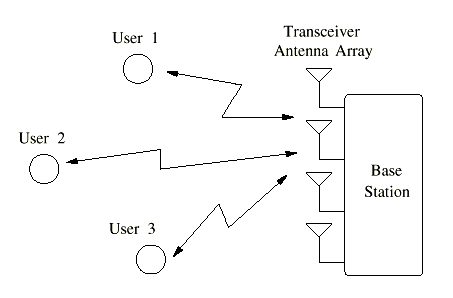

|
JPL's Wireless Communication Reference WebsiteChapter: Analog and Digital Transmission
|
The antenna array must now process, in an optimal manner, a number of received copies of the desired signal, each of which is corrupted by undesirable interference. If there are K significant channel taps observed at the M elements of the array. There are K * M separate data samples to be considered when making a decision on each emitted symbol. This situation requires what is called a ``multichannel'' receiver - it is equivalent to receiving the information over K * M separate narrowband fading channels. This is known as diversity reception. The best approach to this problem is to weight each channel appropriately and combine them together, before making a data decision.
 |
In this page, methods for combining an arbitrary number of channels in a smart antenna will be considered - in the next page, specific receiver structures will be described. The main difficulty in designing such a receiver is to decide how to weight each data sample before combining in the elements. There are many approaches to this problem, but here four fundamental methods will be discussed.
If the receiver has to process a number of multipaths simultaneously, one method is simply to choose the path which is presumed to have the largest signal power. This approach is quite simple, whilst permitting some performance improvement over single antenna receivers. However, this method does not provide the optimum improvement in SINR that can be obtained with the following techniques.
If the interference observed on each separate input is assumed to be uncorrelated, maximal ratio combining is the method which maximizes the SINR of the combined signals. This is particularly effective with l/2 spaced antenna elements in a wide angle spread scenario.
If the receiver employs DPSK detection, the carrier phase reference
is simply the data sample obtained for the previous symbol. The magnitude
of the previous data sample also provides an estimate of the signal amplitude,
so the multi-channels may be combined as follows:
^d(n) = L i =1 S
{z(i, n) z *(i, n - 1)}
where ^d(n) is the estimate of the current transmitted symbol,
z * indicates the complex conjugate operation on the real part of
a complex number. As the combiner weights z * (i, n -
1) are noisy, the SINR of the combined signals tends to be poorer than for
maximal ratio combining. For currently used dual diversity antennas (L
= 2), the loss in SINR at the system operating point is typically less
than 1 dB: however, as L increases the losses become greater.
The three techniques described so far are based on the signal power at the combiner output. It is also possible to use a Wiener filter, which attempts to suppress interference and maximize the SINR at the combiner output. The performance of this technique is likely to be better than that for maximal ratio combining when interference is present. (This principle is also covered MC-CDMA reception. For the DS-CDMA system addressed here, the underlying model and math are similar, but the tap settings will differ.)